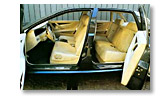At last year’s Detroit show, Claude Lobo – at the time responsible for Advanced Design and since November chief of Car Design, Ford of Europe – explained that a luxury car like the Lincoln had to be like a Chanel dress for a woman: simple, no-frills and very elegant. “It’s a car with a markedly audacious personality,” Lobo now says, “that we wanted to use to explore the potential of Edge Design in a full-size luxury sedan.”

A case in point is the latest arrival, the sub-B Ka, where taut surfaces and straight lines tend to create crossovers and intersections. Pursuing Edge Design principles, the body of the Lincoln Sentinel is treated with great simplicity. Its profile offers a completely smooth flank, whose monolithic appearance is enhanced by large chrome wheels flush to the wheelarches.
The very high beltline is emphasised by a chrome strip that stands proud like the tendon of a muscle, flexing forward to merge with the grille at the front and framing the tail at the rear. The tapered front is characterised by two chrome air ducts to the engine and lighting of vertical development. The rear volume, underscored by the hint of a chrome bumper, rises to join the canopy via twin roof pillars that are ‘invisible’ in the side view.
“In making the Lincoln Sentinel,” says Ghia director Filippo Sapino, “we temporarily turned away from our present-day creative role as designers and returned to our original job from the past. Namely, making fully working cars from style models designed elsewhere.
The style model of the Lincoln Sentinel was actually born in Ford’s Advanced Design Studio at Dearborn, in the USA. So we were reviving one of our traditions from the Fifties and Sixties when we built special cars for leading American makers like Chrysler, Ford and Cadillac. Putting prototypes designed by other people on the road implies a whole series of significant constraints.
This ‘practical translation’ of the project meant first of all resizing the car (performed on the computer), starting out with the original shape of the style model and working towards adapting it to a modified Ford production-derived floorpan to create a package suitable for the Sentinel’s mechanicals, with V12 engine.
At this point a definitive style model was milled with a view to construction, the car being of slightly smaller dimensions than the original model. Real-time data exchange between Turin and Dearborn was made possible via an electronic communications system using computers and teleconferencing – a team effort that involved not only the most sophisticated technology, but also the priceless human and crafts resources that Ghia has kept alive throughout the years.
The article continues in Auto & Design no. 101











